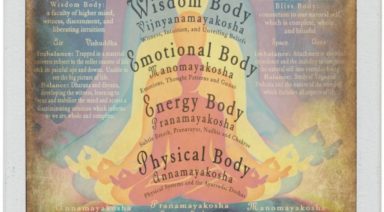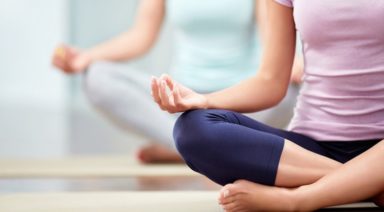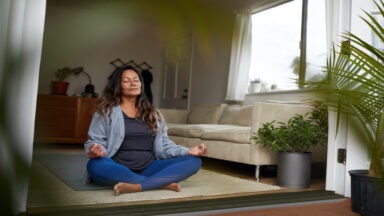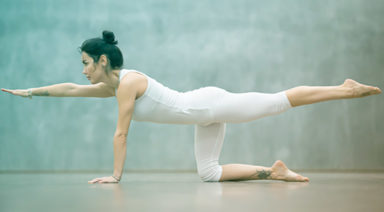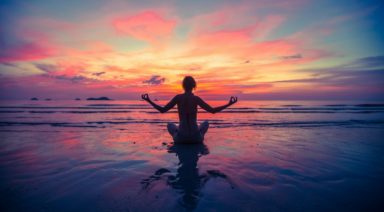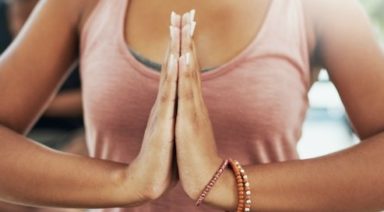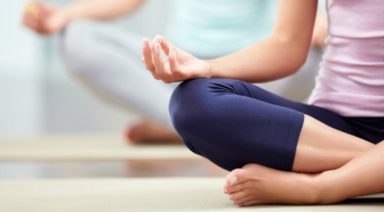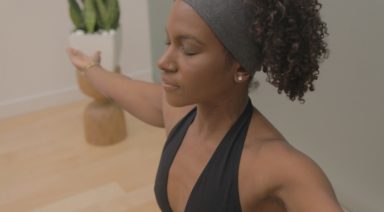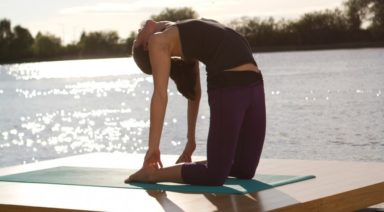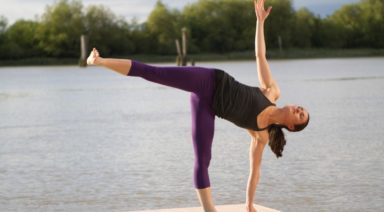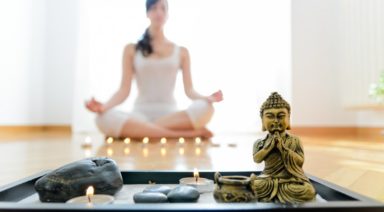Yoga and Eating Do Not Mix
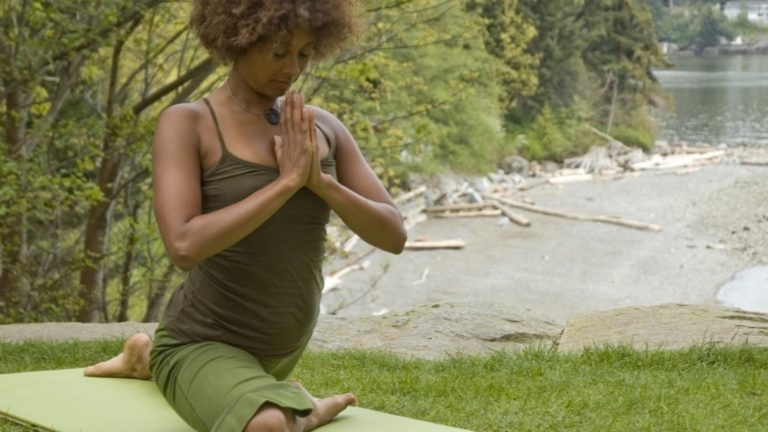
An important preparation for Yoga is avoiding meals prior to the Yoga practice. Generally, we are encouraged to not have eaten 1-2 hours prior to performing Yoga and Breathing (Pranayama) exercises.
Having food in the digestive system can disrupt one’s overall practice. The digestive process requires energy. When food is in the digestive tract, the body requires a full flow of blood to these tissues to nourish the gastrointestinal cells that are processing food material. Energy is required for the contraction of gastrointestinal walls to move food through the system. Energy is required for absorption of nutrients and for the production of hormones, enzymes and other chemicals to manage digestion.
When we perform Yoga poses, these poses and transitions take energy away from the digestive system and, if food is in the digestive tract, this system becomes limited in its’ capacity to digest.
Another consideration of having food in your system while practicing Yoga, is the hydrostatic pressure that can occur. Food moving through the system is generally fluid in consistency. When one twists, bends, and compresses the torso, portions of the gastrointestinal tract can be pinched off (like a balloon filled with water). With further compression from the pose, the food can push outwards (hydrostatic pressure) against the lining of the tract. For some people who are already prone to digestive disorders like diverticulosis, this pressure on the tract linings can lead to damage of theses tissues or aggravate existing conditions.
For those wishing to use Yoga as part of their weight management program, eating before practice is counterproductive. By having an empty stomach, blood sugar levels are at low to moderate levels. Moving into a Yoga practice with an empty stomach allows one to tap more quickly into energy stores (muscles, liver, and body fat). Expending calories from fat stores happens more readily and efficiently. Eating before a practice floods the body and bloodstream with sugars requiring the body to first “burn off” blood sugar calories before accessing other stores. Important note: if you have health concerns like diabetes or hypoglycemia, you should consult a health professional to determine how eating should be approached with Yoga exercises so you can manage your blood sugar levels properly.
Beyond these health issues, other considerations with not eating before practice should be observed:
- food in the digestive system may cause nausea, bloating or gas during practice
- often one needs to go to the washroom while practicing if the digestive system is processing food, thus disrupting one’s practice and connection to the flow
- if practicing on an empty stomach makes the practice difficult (i.e. low energy), eat a small portion of easily-digestible food like apple sauce or yogurt 30-45 minutes before practice. This small amount of food will make its’ way through the system quickly and will not have adverse effects during the practice.
The Meaning of Namaste

About 12 years ago, I double-parked and ran into an Indian food restaurant located in a strip mall in my hometown. I’d had an incredibly long day at work and was craving comfort food and my sofa. When I blazed through the door, I was greeted by a man who stood about the height of my chin. He was the host, the cook, the waiter, and, as I quickly learned, he was also the owner.
He met my cyclone of an entry with a steady kind gaze, and then simply pressed his palms together at his heart, and with a slight reverent bow, said “Namaste.” I had heard the word before, of course, but that moment was different. In that second I felt as though I had just been handed the Nobel Peace Prize. Simply for being me.
I felt seen in a way I never had. Not even by my family or friends or anyone I’d ever dated.
That feeling was created by that single word and his authentic gesture. It transformed not only my day, but also my belief in the power we all have to influence one another with our words, actions and presence. My craving for chutney had somehow ignited my investigation into the history of Namaste.
The Meaning of Namaste
Namaste is a Sanskrit word comprised of the root words “namah” and “te”. The meaning of namah, as described by Wikipedia, means “bow” and “reverential salutation or adoration”. It also means “obeisance” – not a word you may be tossing around with your homies, which means “a movement of the body expressing deep respect or deferential courtesy; a bow, curtsy, or other similar gesture”. The word “te” means “to you”. The “s” links the two words according to the grammatical rules in the language of Sanskrit, so that the sounds of the letters flow with one another. Hearing the resonance of these cohesive sounds shows how and why the language of Sanskrit is precisely aligned with the practice of yoga.
Do I Have to Bow When I Say Namaste?
Like a stiff new pair of jeans, beginning the practice of saying the word Namaste and/or holding your hands at prayer and bowing can feel really uncomfortable. For many born and raised in the western world, there is no cultural equivalent to the practice of bowing. This practice, “pranama” in Sanskrit, means “to bow” or according to Paramahansa Yogananda, “this salutation, with the hands in position of prayer, is expression of reverence to God or to one in whom the Divine is manifested. You may say Pranam or Namaste. This joining of hands symbolizes the meeting of two souls. Bowing down and joining hands symbolizes humility.”
Since Namaste literally means “bowing to you”, it’s a good idea to do just that. Otherwise, it’s as if you proclaim to really like someone while maintaining a poker face. Incorporating the action of bringing your hands to your heart, followed by a slight bow, authenticates the meaning of Namaste.
To Namaste or Not to Namaste
Beyond cultural bounds exists the universality of people greeting one another. Of course you can shake hands, hug, bow or extend a salutation in other ways. But a good Namaste goes a long way.
One of the things I’ve learned as a professional writer is: it’s not just the words we choose that matter, it’s how we use them and if we know what they mean that matters. Words have history, and every word we use carries it’s history with it. Namaste is often interchanged with Namaskar in parts of India and beyond. In ancient scriptures, such as the Taittiriya Upanishad, the practice of extending courtesy, honor and hospitality is expressed equally to guests and deities. It’s referred to as “Atithi Devo Bhav”, which translates to mean ‘the guest is god’. There are 16 forms of reverence used in “Pujas”, or ceremonies, in any place in which formal worship occurs. Namaste is one oform.
As a word and gesture, Namaste has a wide range of uses that can extend along the spectrum of meaning: Namaste or namaskar is used as a respectful form of greeting, acknowledging and welcoming a relative, guest or stranger. It is used with goodbyes as well. Namaste can be used to for both the recipient of a kind deed or favor, as well as by the one extending the giving. The use of Namaste is growing: it is widely used throughout India, Nepal, parts of Asia and beyond. It is often used in yoga studios and spiritual communities throughout the western world.
However, the word itself is incomplete without a connection to the person you are saluting. Eye contact and stopping to acknowledge and bow are equally important.
Namaste is about creating and honoring connection and exuding respect.
As Rodney Yee and Colleen Saidman Yee reflect in Yoga Talks: Why do we say Namaste, “Namaste is used as an expression of respect. The deepest part of me sees and honors the deepest part of you.” They go on to explain that it is a powerful word yet is also familial.
As the word Namaste travels West, it continues to morph into meaning many things to many people. Technically, can I say it to the guy who rotates my tires? The sweet lady who lets me go ahead of her to pay for my groceries? Of course. But it’s more commonly used in situations in which people share a similar view of spiritually or, as in the case with my quest for Chutney years ago, used by people steeped in traditions that teach seeing beyond the exterior to a person’s essence.
That said, I begin each and every yoga and Sanskrit class that I teach with Namaste.
Even when I’m teaching yoga on stand-up paddleboards in lakes, oceans and reservoirs. Regardless of the form of practice, I honor my teachers, and lineages of teaching by using the expression and bow of Namaste. But first I always take a breath. I’ve found for myself that a full conscious inhale and an equally conscious exhale helps to clear away any possible block to connect authentically with both the students present and what I’m about to teach.
How to Say Namaste
As both a teacher and student of Sanskrit for more than ten years, it’s my experience that, here in the U.S., Namaste makes the top ten list for Most Commonly Mispronounced Sanskrit Words.
It does not rhyme with Nescafe; Namaste is a three-syllable word. The emphasis is often incorrectly placed on the first syllable, and erroneously pronounced like ‘nom’. The correct pronunciation phonetically is nuh-mUH-st-hey with the emphasis on the second syllable. In Sanskrit, the ‘a’ sound is pronounced like the English ‘u’ or ‘uh’as in Muenster cheese. There’s a tiny pause, I call it a ‘prana pocket’ that exists just after the second “a” in Namaste, followed by “stay” which, in Sanskrit, sounds like you’re directing your dog to sit. The “t” in Sanskrit is created by placing your tongue in between your upper and lower front teeth, biting down slightly, then pulling your tongue straight towards the back of your throat.
It can feel strange, I know. Practicing that over and over, much like making the shape of Warrior 2 with our bodies, is like washing that new pair of jeans until they fit like you’ve worn them for a decade.
Your Own Private Namaste
One of my Sanskrit teachers gave me some of the best advice for getting comfortable with pronouncing and relating to the names of the postures (asanas) in Sanskrit: “you’ve got to date your asanas… in order to build familiarity, we need to spend time together. It’s no different with relating to the practice of yoga.” There’s no need to light candles and spread rose petals, although if that’s your jam, please go ahead. I’m simply suggesting that, rather than a drive through kind of connection; we spend some quality time with Namaste.
Five Ways to Embody Namaste
Choose Your Context
Try saying Namaste to people practicing next to you in a yoga class or to the cashier at the grocery store.
Look the Other Person in the Eye
In order to recognize the spark of divinity in someone, you must look.
Reverent Gesture
Bring palms to touch at your heart.
Correct pronunciation
Pronunciation phonetically is nuh-mUH-st-hey, with the emphasis on the second syllable.
Bow
It’s not bobbing your head and it’s not full prostration; keep your eyes up and see your gesture all the way through.
We participate in this ancient practice steeped in cultural history because it shows that we value each other, that you could literally turn someone’s day, week or life around in an instant. Exactly like that kind man in the Taste of India restaurant did so many years ago. He bowed to a part of me that I hadn’t yet recognized within my self. In order to see it in myself, I had to forge a relationship with Namaste. If you are going to use this powerful word, explore its meaning.



